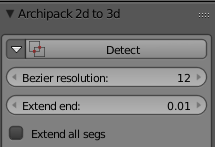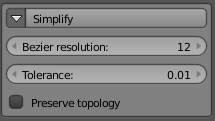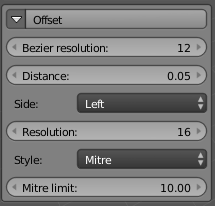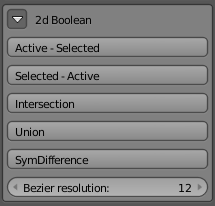2d to 3d¶
Note
2d to 3d tools support bezier and polygons curves as input.
2d to 3d panel is only available when one or more curves are selected / active
2d to 3d tools only work with linear segments, and compute approximation of bezier curves segments at input time.
Detect¶
This set of tools does compute all intersections of a set of curves and detect polygons.
Once detected you may choose between 3 select tools to select lines/polygons and create objects from selection. You are able to use any select tool at any time, detected data remains valid until you reselect another set of curves and repress “Detect”.
Detect find polygons for ~ 1k segment / second, so it may take some time.
Options¶
- Bezier resolution : number of steps to estimate each bezier curved segment.
- Extend end: try to extend segments to find intersections, allow to fill small gaps between lines. Typically 1 cm should be enougth, setting too high will require more time.
- Extend all segs: Extend only work for line ends, when checked the tool will try to extend all segments instead (slowest, but may be safer in some situations).
Typical (generic) workflow¶
- Select one or more curves
- Expand “Detect” options, choose extend limit and extend all segs when apply
- press “Detect”, wait till done ( ~ 1k segment/sec)
- press “Polygons / Lines / Points” to start a select tool
- Select one or many lines, using click and drag to select into an area
- Use keyboard to generate your objects (see on-screen options)
- Repeat 5 and 6 according your needs, then Right click or press esc to exit
Architectural workflow¶
- Clean up, Detect and possibly use “Points” to fill missing parts
- Select curves, and Detect
- Use “Polygons” to create openings objects (windows and doors)
- Use “Polygons” to create walls / slabs, slab cutters..
- Use “Lines” to output guide lines for fences
Select tools¶
(shortcut) Common select actions¶
- a Select all / none
- i Select inverse
- b Select biggest than current (apply only on polygons)
- s Save current selection
- l Load saved selection
- shift Unselect on click or click & drag to unselect in area
- ctrl Select when area fully contains polygon (Deselect when shift is pressed)
Select Polygons¶
This tool allow to select areas and build objects from selection.
(shortcut) Select Polygons actions¶
- o Selection as closed curves
- u Union of selection boundary as closed curves
- f 2d Surface using union of boundarys
- e 3d Wall using union of boundarys
- w start/exit a tool to create Window over selection
- d start/exit a tool to create Door over selection
- r Best fit rectangle of selection as closed curve
Note
Walls done with this tool are not full fledged archipack’s walls.
Creating windows / doors¶
This tool create one object at time. With an area selected, press either w for window or d for door does start a special create tool. Press left mouse and drag to set the desired direction of opening, release to create the object. Pressing w or d when running the create tool cancel the action and allow to select another polygon.
Select Lines¶
This tool allow to select lines and build curves from selection.
(shortcut) Select Lines actions¶
- u Union of selected lines as curve
- f selected lines as curve
Select Points¶
This tool allow to select points and build curves from selection. Intended to fill missing parts of walls, eg when the wall is cut on openings like with doors.
(shortcut) Select Points actions¶
- alt + f best fit rectangle around selected points as curve
- f line as seen on screen as curve
Simplify¶
Simplify input curve(s), using Douglas Peuker method or Topology preserving method. Use this tool to clean up your curves from unnecessary points.
Options¶
- Bezier resolution : input bezier curves approximation.
- Tolerance : Keep points who when removed change the overall shape more than this distance.
- Preserve Topology : use slower Topology preserving method (prevent self intersecting to occur)
Offset¶
Offset is a line at a distance from a curve(s) on it right or left side.
Options¶
- Bezier resolution : input bezier curves approximation.
- Distance : offset distance.
- Side : avaliable side for offset are : left, right.
- Resolution : determines the number of segments used to approximate a quarter circle around a point.
- Style: available styles of joins between offset segments are : round, mitre, and bevel.
- Mitre limit : The ratio of the distance from the corner to the end of the mitred offset corner is the miter ratio. Corners with a ratio which exceed the limit will be beveled.
Tip
While this tool does work with closed splines, when expanding it may result in open curve.
Buffer¶
Buffer is an approximate representation of all points within a given distance of the input curve(s). Use this tool to build eg wall from axis / border, road from axis and so on.
Options¶
- Bezier resolution : input bezier curves approximation.
- Distance : when positive distance has an effect of dilation, when negative erosion.
- Side : avaliable side for buffer are : both, left, right.
- Resolution : determines the number of segments used to approximate a quarter circle around a point.
- Cap: available styles of caps are : round, flat, and square.
- Join: available styles of joins between offset segments are : round, mitre, and bevel.
- Mitre limit : The ratio of the distance from the corner to the end of the mitred offset corner is the miter ratio. Corners with a ratio which exceed the limit will be beveled.
Tip
While this tool does work with closed splines, endpoints may suffer from square cap artefact.
Boolean operations¶
Provides 2d boolean operations between curves. Boolean is able to take account of the closed state of curves (areas).
Operations¶
- Union
- Intersection
- Differences (selection - active and active - selection)
- Symmetric difference
Tip
2d to 3d Detect method can be significantely faster when performing complex operations between many objects.







